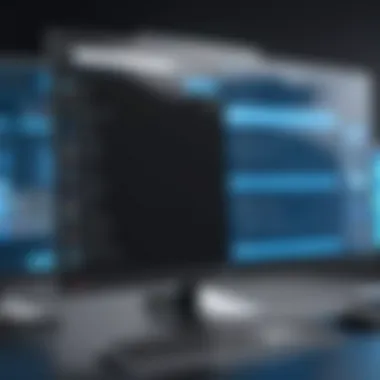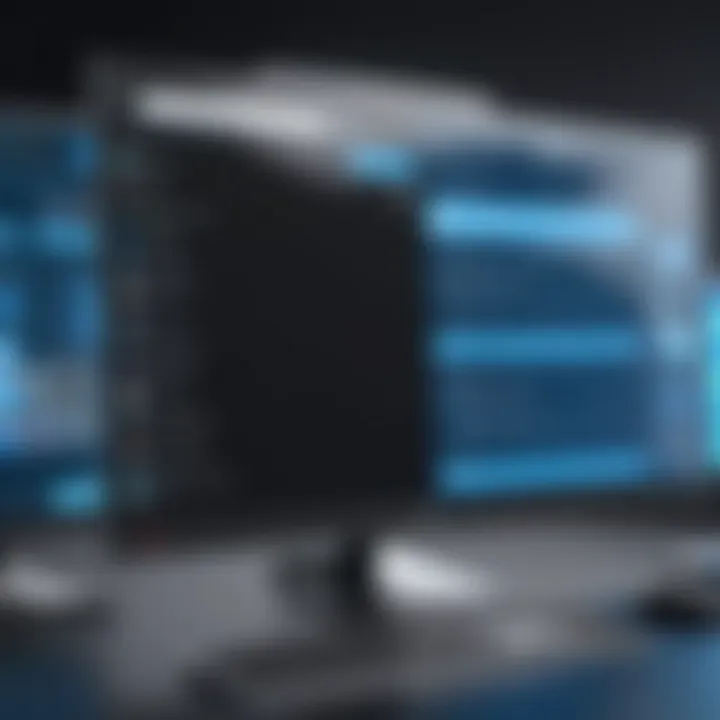Upgrade from Windows 10 to Windows 11: A Complete Guide


Intro
Upgrading your operating system can feel a bit like stepping across the threshold into a whole new world. For many, this means leaving the comforts of Windows 10 and embarking on the journey to Windows 11. This upgrade not only brings a fresh interface and new features, but it also evokes questions about compatibility, performance, and user experience. The objective here is to illuminate every facet of this transition, ensuring that you can navigate the upgrade process with confidence and ease.
The upcoming sections will dissect critical system requirements and explore how Windows 11 distinguishes itself with its innovative features. For those who thrive on efficiency and performance, the article will offer insights into the expected speed enhancements and how battery life may be impacted during this upgrade. Moreover, we will tackle potential roadblocks you might face along the way and troubleshoot common issues.
In essence, this guide will cater not just to the casual user but also to tech aficionados and IT professionals keen on mastering the intricacies of this upgrade. Stick around, as we delve deeper into what Windows 11 has in store for you.
Intro to the Upgrade
When considering the leap from Windows 10 to Windows 11, one quickly realizes that this isn't merely a routine update but rather a significant shift in how users engage with their technology. The importance of understanding the upgrade process stems largely from how intertwined our personal and professional lives have become with our computing devices. Windows 11 brings along not just aesthetic refinements but also a substantial change in user experience and system efficiency. For tech enthusiasts and general consumers alike, grasping the nuances of this transition is crucial for making informed decisions that could greatly affect everything from productivity to connectivity.
Context of Windows Upgrades
Upgrading Windows shouldn't be considered a mere checkbox to tick off. It's an evolution of sorts that arises due to several factors, ranging from security enhancements to improved usability. Microsoft has delivered various iterations of Windows, each with its unique features, bugs, and architectural changes. Understanding the context of these upgrades sheds light on their purpose.
For instance, with the approach of Windows 11, Microsoft has made it very clear that it's not just another cosmetic improvement. They aim to redefine the working and gaming experience by creating smoother interfaces and richer user engagement. This context emphasizes that upgrades are often not just about new features but about adapting to technology trends and user feedback.
- Over the years, we've seen significant changes with each version:
- Windows Vista introduced a new visual style.
- Windows 7 focused on performance improvements.
- Windows 10 emphasized cross-device compatibility.
- And now, Windows 11 merges performance with user experience.
The narrative of Windows upgrades illustrates the ongoing development and sustenance of user satisfaction, thereby setting a precedent that is often overlooked during the handover from one version to another.
Why Consider Upgrading?
Choosing to upgrade from Windows 10 to Windows 11 comes with its considerations. The upgrade presents an opportunity to harness features that may significantly enhance user experience. Some compelling reasons to contemplate this jump include:
- Enhanced User Interface: Windows 11 offers a more streamlined and engaging interface that can make navigation feel both intuitive and pleasant.
- Performance Boosts: Early reports suggest that users are experiencing faster boot times and improved application performance, translating into better day-to-day usability.
- Improved Gaming Features: For those who enjoy gaming, Windows 11 launches with integrated features designed to optimize performance for an enriched gaming experience.
- Increased Security Protocols: As cyber threats continue to evolve, Windows 11 includes heightened security measures aimed at safeguarding user data more robustly.
Of course, all these features are moot if an individual’s hardware isn’t up to par. It’s essential then to evaluate whether one’s current system meets the requirements for Windows 11. Each of these factors brings to light critical benefits, but they also necessitate a deeper understanding of what the new operating system asks of its users. It’s not merely a matter of upgrading; it’s about upgrading wisely.
System Requirements for Windows
When contemplating an upgrade to Windows 11, understanding its system requirements becomes paramount. Not only does it dictate who can transition to this new operating system, but it also plays a critical role in ensuring the optimal performance of the system. The essence of these requirements is to prevent users from experiencing software limitations that could lead to frustration. Windows 11 introduces a slew of enhancements and features designed to improve your computing experience, and meeting these requirements is the first step in leveraging all that it has to offer.
Minimum Hardware Specifications
To get started with Windows 11, certain baseline hardware specs are necessary. Here’s a detailed breakdown of what's required:
- Processor: A compatible 64-bit processor with at least 1 GHz clock speed and a minimum of two cores is essential. This eliminates older single-core CPUs, ensuring that your experience is smooth and undelayed.
- RAM: Windows 11 calls for a minimum of 4 GB of RAM. In layman's terms, this is akin to needing a decent amount of elbow room when hosting a dinner party – everyone needs space to breathe and mingle.
- Storage: You’ll need at least 64 GB of storage. Though this might seem like a no-brainer, it’s crucial for housing not just the OS, but also applications and data.
- Firmware: UEFI firmware is specified, alongside Secure Boot capability. This is akin to having locks on your doors for added security.
- TPM: At least a TPM version 2.0 is also a requirement. This Trusted Platform Module ensures that your device is secure from the ground up, safeguarding sensitive information.
- Graphics Card: To enjoy Windows 11’s visual aesthetics, a DirectX 12 compatible graphics card is needed, coupled with a WDDM 2.0 driver. It’s like having a good paintbrush to express creative artistry.
- Display: A high definition (720p) display, greater than 9 inches in diagonal, tops the list. This is important for proper legibility and user interaction.
Meeting these basic specs might seem like crossing a bridge before figuring out the final destination. However, these foundational elements ensure that every feature, from the new widget system to various productivity enhancements, runs seamlessly, making all the difference in your day-to-day user experience.
Optional Features and Their Requirements
Beyond the minimum specifications, Windows 11 includes a range of optional features that can significantly impact user experience positively. Understanding these can help you decide whether to invest additional resources into hardware upgrades.
Some noteworthy optional features include:
- Virtual Desktops: For users looking to create multiple desktop environments, having an Intel i5 or AMD Ryzen 5 processor or better helps manage more demanding tasks smoothly.
- Touch Support: To capitalize on touch interface capabilities, a touchscreen display is essential. It amplifies interactivity, making tasks feel more fluid.
- Windows Hello: This biometric access feature requires specific hardware, such as a fingerprint reader or an infrared camera. This makes logging into your system feel like a high-tech experience, moving away from traditional passwords.
- DirectStorage: Designed for better loading times in games, it necessitates an NVMe SSD. This feature leverages the latest in storage tech, which can drastically lower wait times when launching applications.
Understanding these optional features enables you to tailor your Windows 11 experience further. Whether you prioritize gaming, professional tasks, or multimedia creation, ensuring your system can accommodate various options is a vital consideration in extending your device’s lifespan and capability.
It is always recommended to keep your system specifications updated, as it enhances longevity and unlocks the potential of new software advancements.
Features of Windows
Windows 11 brings a host of new features that significantly enhance user experience, performance, and security. As you contemplate upgrading, understanding these features is crucial, because they represent not just aesthetic changes but also upgrades in functionality. They aim to streamline workflows, make user interaction more intuitive, and bolster overall system safety.
User Interface Enhancements
The first thing that often catches the eye in Windows 11 is its revamped user interface. Say goodbye to the square corners and hello to a more fluid design. Microsoft took a step back to rethink how users interact with their devices. The new centered Start menu mimics a more mobile experience, making it easier for folks to find their apps without rummaging. It’s like organizing your drawer; everything has its place.
"The aesthetic is not just about looking good; it’s formulated with productivity in mind."
Moreover, the taskbar offers richer integration with touch inputs, perfect for devices with touch screens. If you’ve got a Surface device, you’ll feel the difference right off the bat. And let’s not forget the Snap Layouts, which make multitasking armchair-easy. You can organize your windows in predefined layouts with a simple hover, achieving a decluttered workspace without needing to take out a ruler.
Performance Improvements
Beyond looks, performance in Windows 11 is where the rubber meets the road. Under the hood, this new OS is designed to increase responsiveness, which is something that any tech enthusiast salivates over. Microsoft claims that Windows 11 optimizes foreground performance, ensuring your active applications run smoothly while background tasks don't hog resources unnecessarily. It’s like a well-tuned sports car, where every part works harmoniously to deliver that thrilling ride.


Additionally, support for DirectStorage makes game loading times a breeze. Gamers will find that they can jump into their worlds faster than making a cup of coffee. We’re talking about utilizing high-speed NVMe SSDs that dramatically reduce wait times, making the gameplay experience seamless.
New Security Features
In today’s world, the importance of security can’t be overstated. With Windows 11, Microsoft is stepping up its game in this department. One notable feature is the built-in support for TPM 2.0, which enhances system integrity and security. It's like having a fortified lock on your front door—why settle for anything less?
Windows 11 also introduces hardware-based isolation, meaning all Windows processes run in secure containers. This shields against harmful malware that aims to exploit system vulnerabilities. These moves signal Microsoft’s commitment to keeping users safe in a digital landscape fraught with risks.
As an added layer of protection, Windows Hello allows for quicker and more secure logins via facial recognition or fingerprint scanning, putting old-school passwords on the backburner.
In summary, the features of Windows 11 are designed not just to dazzle the senses, but to enhance experience, performance, and security. As we move towards a more interconnected world, staying updated with the latest technological advancements seems like a no-brainer.
Preparation for the Upgrade
Preparing for an upgrade from Windows 10 to Windows 11 is not merely a suggestion; it’s akin to laying the groundwork for a fruitful endeavor. This step can’t be glossed over if you want a seamless transition. The preparation process can save users a considerable amount of time, frustration, and potential loss of data. Here’s why getting ready is of utmost importance.
One of the primary benefits of preparing is ensuring that you have backups of important files. Upgrading can sometimes lead to unexpected issues, and having your data secured is a safety net for when the proverbial chips are down. In addition, checking system compatibility will save you from an upgrade experience that lands you in a bog of hardware limitations and driver discrepancies.
Considering these preparatory steps can make the eventual upgrade process smoother and more efficient. Let’s delve into the specifics of what this preparation entails.
Backing Up Your Data
Before attempting the upgrade, it’s vital to back up your data. If anything goes awry—and it can—it’s a peace of mind to know your files are safe. Most folks have experienced that sinking feeling when they lose something significant. So, let’s avoid that heartbreak.
- Choose Your Backup Method: Options abound here. You might use cloud services like Google Drive or Dropbox, or employ an external hard drive. Both methods have their pros and cons. Cloud solutions offer accessibility and automatic backups, while physical drives give you tangible control over your data.
- Select What to Back Up: Not every file needs to come along for the ride. Focus on important documents, media files, and any specific application data you can’t easily recreate.
- Perform the Backup: Carry out the backup process, keeping an eye on storage space and completeness. Checking that all vital files are included should be part of your checklist.
Backing up your data is not just a safety measure; it’s an essential habit for any tech-savvy individual or enthusiastic gadget lover.
Checking Compatibility
Next on the agenda is checking compatibility with Windows 11, which can feel a bit like trying to fit a square peg in a round hole if not done correctly. Windows 11 comes with a list of system requirements that must be met for the upgrade to work smoothly.
- Review System Requirements: Familiarize yourself with minimum hardware specifications, such as CPU, RAM, storage, and TPM version. Ensuring your device meets these prerequisites is crucial.
- Utilize Microsoft's PC Health Check Tool: This tool is designed to help assess whether your current hardware is compatible with Windows 11. Simply run the program, and it will flag any potential issues.
- Confirm Software Compatibility: Beyond hardware, consider any essential programs you use. Certain software might not function well, or even at all, post-upgrade. Knowing this in advance helps you prepare or seek alternatives.
From this process, you'll either feel reassured that your rig is ready or know precisely what needs attention.
Backup and compatibility checks are not just steps; they're the foundation to a successful upgrade experience.
In summary, taking the time to prepare can mean the difference between a smooth and potentially painful transition into Windows 11. Don't rush in blind. Instead, step methodically and ensure your upgrade is as enjoyable as it should be.
The Upgrade Process
Understanding the upgrade process is essential when transitioning from Windows 10 to Windows 11. It represents the bridge connecting the previous operating system to the latest version, ensuring users can experience new features and improved functionality without a hitch. Not only does it allow users to check if their current systems are compatible, but it also provides a straightforward method to install the update via various routes. By grasping the nuances of this process, users can minimize disruption and stay informed about potential benefits and considerations that accompany the upgrade.
Using Windows Update
Utilizing Windows Update is often the simplest and most effective way to upgrade to Windows 11. This method streamlines the entire process by automating many of the steps involved, thus reducing the risk of errors and eliminating the need for external tools.
- Check for Updates: First things first, ensure your current Windows 10 is current. Head to Settings > Update & Security > Windows Update and click on "Check for updates." This will search for any pending updates and if Windows 11 is available, it will show up.
- Start the Process: Once Windows 11 is detected, click the option to download and install. The progress will be displayed, and it might take some time depending on your internet speed and the size of the update.
- Follow On-Screen Instructions: Active guidance during installation helps to make decisions user-friendly. Simply follow the prompts on your screen until the upgrade finishes.
- Reboot and Enjoy: After the installation is complete, a reboot is required. Once you log back in, you can start exploring the new features and improvements.
Using Windows Update saves a lot of headaches and is suitable for users who prefer a less hands-on approach. The often seamless aspect of this method makes it favored among everyday users, but it's good to keep in mind that some may experience a longer wait time if Microsoft phases out the rollout of the update.
Manual Installation via ISO File
For those who prefer a more hands-on approach or need to perform the installation on multiple devices, manual installation via an ISO file can be an effective solution. This method is particularly useful for IT professionals managing various systems or those looking to install Windows 11 on hardware that may not trigger an automatic update.
- Download the ISO: Start by going to the official Microsoft website, where you can find the Windows 11 download page. Here, you can select to download the ISO file for creating installation media. Make sure you are also fetching the correct version that matches your system architecture (32-bit or 64-bit).
- Creating Installation Media: After downloading the ISO, you will need a USB drive. Use tools like the Windows Media Creation Tool or similar to create a bootable USB drive from the ISO. This will allow you to install Windows 11 directly from the USB.
- Prepare for Installation: Before beginning the installation, ensure all your important data is backed up, as this process could lead to data loss if not done carefully. Double-check your hardware compatibility as well.
- Run Installation: Plug in the USB drive and restart the system. Access the BIOS/UEFI settings, and set the boot order to prioritize the USB drive. Once it boots, follow the prompts to install Windows 11.
- Final Steps: Be prepared to format your drive if you choose a clean installation, or select to keep your files if you're doing an upgrade. Once set, the installation will finalize and prompt for a restart.
Installing via an ISO file places control firmly in the user’s hands. However, this option demands a certain level of technical ability and familiarity with computer systems that some users may not possess.
"Always ensure that your data is fully backed up before beginning an installation, as this is an essential step that many overlook."
Opting for either the automatic update process or the manual ISO installation presents users with unique pros and cons, depending on individual needs and preferences.
Post-Upgrade Considerations
Upgrading to Windows 11 brings a new array of tools and features, but a successful transition depends heavily on paying attention to what comes after the upgrade. Post-upgrade considerations are crucial since they determine how smoothly the new operating system integrates into your existing environment. This stage is not just about using the new system; it’s about maximizing its potential, ensuring optimal performance, and troubleshooting any hiccups that may arise during the initial exposure.
Initial Setup and Configuration
After the upgrade, the first order of business is the initial setup and configuration. As you boot up Windows 11 for the first time, you’ll be greeted with an intuitive setup guide that prompts you through several key processes. Here’s a breakdown of what you can expect:


- Personalization: Windows 11 allows you to choose a personalized look and feel. From dark mode to taskbar positioning, these small tweaks make a big difference in user experience.
- Account Configuration: You’ll need to sign in with a Microsoft account. If you don't already have one, it's a simple process that lets you sync settings across devices.
- Privacy Settings: Be sure to review the privacy options. Windows 11 has different default settings than Windows 10, and adjusting these can keep your data safe.
- Updates: Check for any pending updates right away. Even after an upgrade, Microsoft often issues patches to fix bugs or improve features, so keeping the OS up to date is paramount.
- Driver Installation: Sometimes, specialized hardware needs updated drivers. Enable Windows Update to search for the latest drivers automatically, or visit the manufacturer’s website for specific updates.
The setup process is quick but significant. The changes you make here can lay the groundwork for how well you enjoy the new features of Windows 11.
Exploring New Features
With the setup wrapping up, it’s time to explore the fresh features of Windows 11. One of the hallmarks of this version is its user-centric design, focusing on efficiency and enhancing the overall experience. Some standout features include:
- Snap Layouts: This feature makes multitasking easier by allowing you to snap multiple windows into organized layouts.
- Widgets: A revamped widgets panel provides quick access to news, weather, and other information tailored to your interests, saved as shortcuts for convenience.
- Direct Storage: For gamers, this technology significantly reduces load times by allowing games to load assets directly from the SSD.
- Virtual Desktops: Enhanced capabilities for managing multiple desktops allow you to create individualized workflows depending on the tasks at hand.
"Being familiar with these features is one way to ensure you're not leaving any potential productivity on the table."
Understanding these new functionalities can drastically change how you work and interact with your computer. Whether you're going for a more streamlined approach or diving into multitasking, learning the ins and outs of Windows 11’s new offerings can enhance both your efficiency and enjoyment of the system.
Common Challenges During the Upgrade
When moving from Windows 10 to Windows 11, users often find themselves grappling with a range of obstacles. This section addresses these challenges, as they are crucial for ensuring a seamless transition. Recognizing potential pitfalls ahead of time can save time, frustration, and even data loss. By tackling these common issues, users can learn strategies to mitigate risks and navigate the upgrade with greater confidence.
Installation Errors
One of the most frustrating aspects of upgrading is encountering installation errors. These can manifest in various forms—error codes, system freezes, or even the dreaded blue screen of death. The root cause often varies from one user to another, depending on hardware configurations and software environments.
To minimize these errors during installation, it's prudent to:
- Ensure that your system meets the minimum requirements for Windows 11.
- Disable any third-party antivirus or firewall temporarily.
- Disconnect any unnecessary peripherals (printers, external drives) during the installation process.
Getting the scoop on error messages: Each installation error typically comes with a specific code or message. Researching these codes can lead you to tailored solutions. Communities on forums such as Reddit often share their experiences and fixes that can be valuable.
"Patience is the key. Sometimes, a simple restart can sort out what seems to be an insurmountable problem."
Compatibility Issues with Software and Hardware
Compatibility is another sticking point for users migrating to Windows 11. Not all software and hardware are designed to work seamlessly with this latest iteration of Windows. Problems may include outdated drivers, legacy applications failing to launch, or peripherals that can no longer perform as expected.
To proactively address compatibility issues, consider the following steps:
- Check software compatibility: Look at the websites or forums of the software providers where they often post updates or patches enabling their programs to function with Windows 11.
- Update drivers: Keeping your hardware drivers updated is essential. The manufacturer’s website usually provides the latest versions needed to run on the new operating system.
- Utilize Windows Compatibility Mode: Sometimes, using the compatibility mode feature allows older software to run as if it’s on a previous version of Windows.
The critical takeaway here is the need for due diligence before making the leap into Windows 11—knowing what to expect can help one prepare for an ultimately smoother upgrade experience.
Troubleshooting Post-Upgrade Issues
When diving into a new version of an operating system, it's not all rainbows and butterflies. Windows 11, while modern and feature-rich, may present some hiccups after you’ve made the leap from Windows 10. Recognizing how to troubleshoot these issues not only eases frustrations but also enhances the overall user experience. Let’s explore this further.
Resolving Common Bugs
One of the inevitabilities of upgrading software is encountering bugs that disrupt smooth functionality. Common issues range from minor annoyances, like slow startup times, to significant problems that could hinder daily tasks.
Here are key suggestions to help you squash those bugs:
- Check for Updates: Microsoft continuously releases patches and updates for Windows 11. Staying up to date often resolves known issues.
- Run the Troubleshooter: Built into Windows 11 is a handy troubleshooter tool. Found in the settings menu, it assists with various problems like printer connectivity and network glitches.
- Uninstall Problematic Apps: If you notice rough performance post-upgrade, take a good look at third-party applications. Some may not be fully compatible. Consider uninstalling them until updates arrive.
- System Restore: In more drastic cases, using the system restore feature allows users to revert their system to a point before the upgrade or before problems began.
Another useful tip, as per users on reddit.com, is to check the Task Manager for programs that may be using up an unusual amount of resources. It could be that a rogue app is responsible for slowing down your system.
Reverting Back to Windows
Sometimes, people find themselves longing for the familiar terrain of Windows 10 after attempting Windows 11. That's perfectly normal. If, after tinkering around, you realize that the new features aren’t your cup of tea, there’s an avenue to undo the upgrade.
- Timeframe for Reverting: Keep in mind that you can roll back to Windows 10 within 10 days of the upgrade. After this period, the option might disappear, along with the previous files.
- Accessing Recovery Options: To revert, head to Settings > System > Recovery. There, the option to return to Windows 10 will be readily available, guiding you through the necessary steps.
- Back Up Files: Before taking the plunge to revert, remember to back up your data. Although the process should preserve your files, it’s always best to be cautious and save anything crucial elsewhere.
Navigating post-upgrade issues may seem daunting, but with a toolkit of troubleshooting strategies and an open mind, it becomes simply a part of the transition journey. Always remember; the more informed you are, the smoother this process can be.
Optimizing Windows for Performance
Optimizing Windows 11 for performance is crucial for getting the most out of your system. A well-tuned operating system can lead to faster load times, snappier response, and an overall smoother experience. As users dive deeper into a variety of applications and multitasking, a robust performance optimization strategy becomes indispensable. This ensures not only productivity but also plays a significant role in enhancing the longevity of hardware. It's a matter of unlocking potential that might go unnoticed otherwise.
Adjusting System Settings for Better Performance
When it comes to tweaking Windows 11 for better performance, you might want to start right in the settings. Delving into the system settings can feel a bit like rummaging through a toolbox; each adjustment can yield varying outcomes, but you have to choose wisely to foster a more efficient workflow. Here are some steps you can take:
- Power Settings: Set your power plan to "High Performance". This allows your CPU to run at maximum capacity when needed. To tweak this, go to Settings > System > Power & battery. Choosing High Performance can make a noticeable difference, especially for resource-intensive tasks like gaming or video editing.
- Startup Programs: Check which applications are hogging your resources while booting up. Navigate to Task Manager by right-clicking the taskbar and selecting it. Under the Startup tab, disable programs that you don’t need right off the bat. This helps in speeding up your startup time and improves system responsiveness.
- Visual Effects: Windows 11 comes with a lot of visual flare that’s delightful but maybe not the best for performance. Turning down these effects can make a world of difference. Head over to System > About > Advanced system settings, under Performance, select "Adjust for best performance". You can always customize it afterward by enabling a few visual effects you still wish to retain.


Utilizing Built-in Optimization Tools
Windows 11 is not short on built-in optimization tools that help enhance performance without requiring third-party software. These can be a game changer and often fly under the radar. Here’s how to leverage them:
- Storage Sense: This tool automatically frees up space by deleting temporary files and content from your recycle bin. Head to Settings > System > Storage and toggle on Storage Sense. Configuring this to run during idle times can ensure that your storage stays optimized with minimal hassle.
- Disk Cleanup: A traditional but effective utility that can help reclaim disk space. It allows users to remove unnecessary files including system files, temporary files, and installation files from previously removed software. Just search for "Disk Cleanup" in the Start menu, select the drive, and choose the types of files you want to delete. This isn't just about space but can also improve read and write speeds on the disk.
- Task Manager: This isn’t just for monitoring performance, but can also help in managing running processes that might slow down your computer. Look under the Performance tab where you can see the overall CPU, memory, disk, and GPU usage. If something seems out of line or particularly heavy—tasks you don't recognize can often be a good target for termination or further investigation.
By regularly adjusting settings and utilizing the right tools, you can maintain an efficient environment that lets Windows 11 shine at its best.
Getting the hang of these strategies can take a little time, but once you do, you’re likely to enjoy a system that operates not just adequately, but excellently, reflecting the power of technology at your fingertips.
User Feedback and Adoption Rates
Understanding user feedback and adoption rates holds significant weight in evaluating any operating system upgrade. It acts as a litmus test, gauging user satisfaction and acceptance levels, helping both Microsoft and potential upgraders understand what works and what doesn’t. For a tech-savvy audience, the nuances within these responses can reveal much about the usability, functionality, and long-term viability of Windows 11 versus its predecessor, Windows 10.
Community Reactions to Windows
The buzz around Windows 11 was palpable even before its launch. Enthusiasts discussed the changes across forums like Reddit and Facebook, offering a mixed bag of opinions. Many users praised the fresh interface and taskbar improvements, asserting that the streamlined aesthetic made for a more pleasant experience.
Conversely, not all feedback was glowing. A segment of users expressed concern about system requirements, signaling frustration with hardware compatibility. Comments like "I can’t run it on my machine, guess I’m stuck with 10 for now" were common.
In particular, the focus on gaming features drew mixed reactions. Users were eager to embrace DirectStorage technology for better load times in games but voiced worries about potential performance dips on older hardware. Such feedback is crucial, as it highlights the divide between technology enthusiasts eager for the latest features and everyday users who might struggle under the new demands.
Moreover, Microsoft has taken a proactive approach, actively engaging with the community to address concerns and gather feedback, which demonstrates their commitment to refining user experience. This communication fosters trust and transparency, essential during any significant upgrade. Users appreciate knowing their voices are heard, especially when facing significant changes.
Analyzing Adoption Statistics
When looking at adoption rates, the early figures show an encouraging trend for Windows 11. Within the first few months post-launch, adoption was swift, with around 14% of eligible PCs upgrading within the initial stages.
However, it’s not just about numbers; the how and why behind these statistics are critical. For instance, the hardware requirements play a major role in shaping adoption speeds. Increased minimum requirements mean many users are left on the sidelines. Various studies indicate that dissatisfaction with the upgrade process can lead to a reluctance to switch, revealing the importance of smooth transitions.
Furthermore, looking at specific demographics can be telling. Tech enthusiasts and professionals are more likely to upgrade quickly, while average consumers may take a wait-and-see approach given the steep learning curve and potential complications.
Adoption will also fluctuate based on regional factors, with certain markets adopting faster due to better marketing and availability.
In a constantly evolving tech landscape, understanding user perspective through feedback and adoption trends is indispensable to shaping enhancements and future updates.
In summary, user feedback and adoption rates tell a detailed story about Windows 11's place in today’s tech ecosystem. They provide insight not just for Microsoft, but also for users evaluating the software. Are the new features worth the potential hassle? These metrics help answer that question and assist in navigating the upgrade landscape with care.
The Future of Windows Updates
Staying ahead in the tech world often hinges on how well systems can adapt and evolve. This is especially true for operating systems, where the demands of users and advancements in technology set a high bar. The future of Windows 11 updates is a critical topic for both individual users and enterprises, as it can determine how the operating system integrates new features, enhances security, and improves performance. Understanding these updates can help users make informed decisions about their tech investments.
Expected Features and Enhancements
It’s no secret that Microsoft has big plans for Windows 11, aiming to keep the platform relevant in a fast-changing environment. Experts predict various up-and-coming features that could make their way into future updates. These might include:
- Revamped Widgets: Windows 11 currently provides widgets, but the next iterations may offer more customization and interactivity, aiming to make them more user-friendly and engaging.
- Improved Virtual Desktops: Enhancements to virtual desktops could streamline work for users juggling multiple projects. Features like better organization and even customizable backgrounds per desktop might be on the table.
- Expanded Gaming Features: With gaming being a top priority, expect to see continued focus on optimizing performance for gamers, including updates to DirectStorage and Auto HDR, which were recently included to enhance the gaming experience.
- Integration with Cloud Services: As cloud computing grows, Windows 11 may feature deeper integrations with Microsoft 365 and OneDrive, making it easier for users to access their files on the go without missing a beat.
These features are not just enhancements; they represent a shift in how users interact with their devices on a daily basis. However, the realistic rollout of these features will depend heavily on the underlying architecture and ongoing feedback from the user community.
Microsoft's Update Strategy Moving Forward
Microsoft has publicly committed to a more transparent and agile approach to updates. The tech giant emphasizes
"the need for regular updates that do not just focus on fixing issues but also introduce genuine enhancements based on user feedback."
This approach can be seen in several key initiatives:
- Frequent Updates: Rather than the traditional bi-annual release schedule, users might expect quarterly updates that address performance, security, and add new functions more regularly.
- User-Centric Feedback Loops: Microsoft seems keen on prioritizing user feedback, thus influencing which features take precedence. Engaging communities on platforms like Reddit will likely lead to more informed and responsive updates.
- Security First: Given the rising tide of cyber threats, future updates will likely have a sharper focus on security enhancements. Expect more robust protections against malware and ransomware.
- Wider Hardware Compatibility: Microsoft may also expand the horizons regarding the kinds of hardware that can run new features better. This would bolster inclusivity, allowing more users to adopt the latest improvements without needing an immediate upgrade of their systems.
As Windows 11 forges ahead, the balance of innovation and flexibility will be of paramount importance. For early adopters and tech enthusiasts alike, following these developments can make all the difference in maximizing their experience with the operating system.
Closure
When looking back at the journey through upgrading from Windows 10 to Windows 11, it’s clear that this transition encapsulates both challenges and opportunities. Understanding the nuances involved not only facilitates a smoother upgrade process but also enhances the overall user experience.
Summarizing Key Points
To summarize the salient points discussed in the article:
- System Requirements: Windows 11 has specific minimum hardware specifications that are essential for proper functionality. Users must ensure their devices meet these requirements before proceeding with the upgrade.
- Key Features: The redesigned user interface, performance improvements, and new security features distinctively position Windows 11 as a modern OS tailored to user needs.
- Upgrade Process: Whether opting for the Windows Update method or a manual installation using an ISO file, understanding the processes involved helps in navigating through various upgrade scenarios proficiently.
- Post-Upgrade Actions: Post-upgrade, users are encouraged to explore new functionalities, make custom settings, and optimize their system for peak performance.
- Common Challenges: Awareness of potential installation errors, software compatibility issues, and troubleshooting methods can save time and frustration.
- The Future of Updates: Microsoft’s commitment to regularly scheduled updates promises continuous improvements and new features aimed at enhancing user experience over time.
Final Thoughts on Upgrading
Ultimately, the decision to upgrade is not merely about acquiring a newer version of an operating system; it’s an opportunity to embrace enhanced functionalities and improved performance. The move to Windows 11 marks a notable shift in how we interact with technology. It’s important for users—whether they are casual or tech-savvy—to consider both the advantages and challenges that come with this upgrade. Investing time to understand the implications of such a transition can make a world of difference.
In contemplating the benefits, the new features can enrich user productivity and security, while the performance enhancements can breathe new life into older devices. To sum it all up, upgrading from Windows 10 to Windows 11 stands not just as a simple update, but as a relationship building effort with emerging technology in a rapidly evolving digital landscape.
"Every transition holds the power to reshape our interaction with technology, and the switch from Windows 10 to Windows 11 is no exception."

